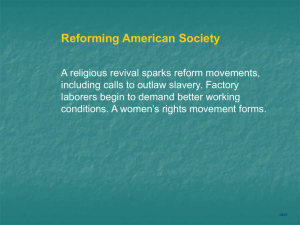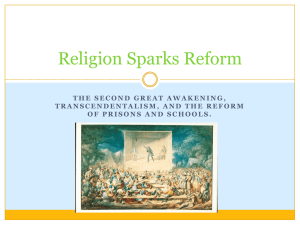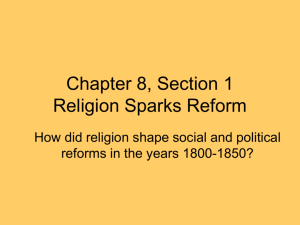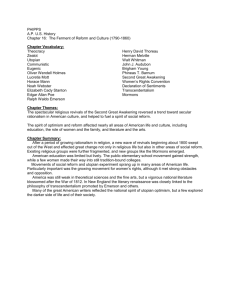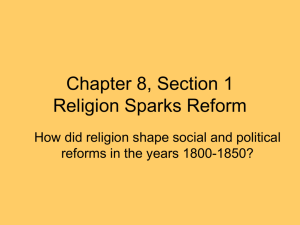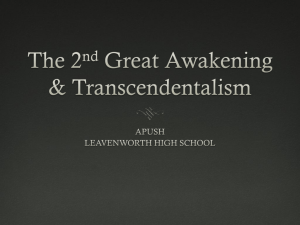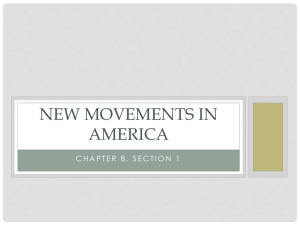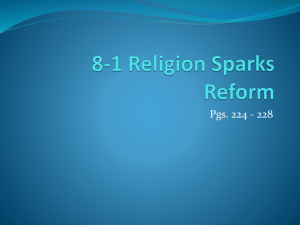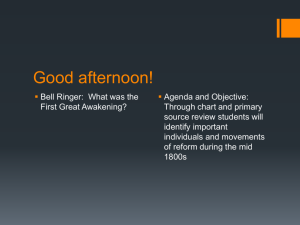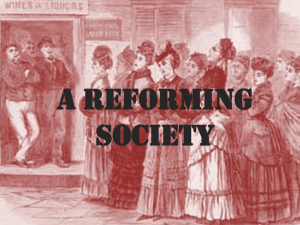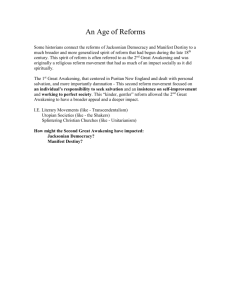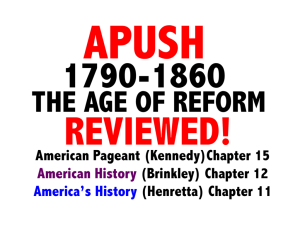Chapter Eight, Section One
advertisement
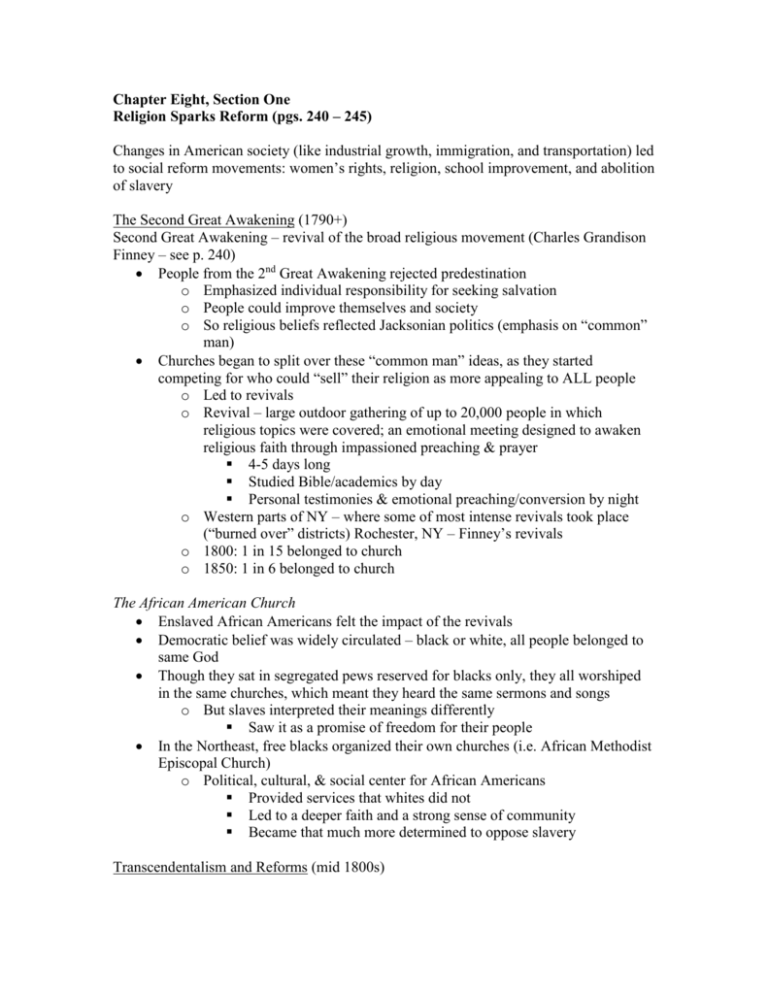
Chapter Eight, Section One Religion Sparks Reform (pgs. 240 – 245) Changes in American society (like industrial growth, immigration, and transportation) led to social reform movements: women’s rights, religion, school improvement, and abolition of slavery The Second Great Awakening (1790+) Second Great Awakening – revival of the broad religious movement (Charles Grandison Finney – see p. 240) People from the 2nd Great Awakening rejected predestination o Emphasized individual responsibility for seeking salvation o People could improve themselves and society o So religious beliefs reflected Jacksonian politics (emphasis on “common” man) Churches began to split over these “common man” ideas, as they started competing for who could “sell” their religion as more appealing to ALL people o Led to revivals o Revival – large outdoor gathering of up to 20,000 people in which religious topics were covered; an emotional meeting designed to awaken religious faith through impassioned preaching & prayer 4-5 days long Studied Bible/academics by day Personal testimonies & emotional preaching/conversion by night o Western parts of NY – where some of most intense revivals took place (“burned over” districts) Rochester, NY – Finney’s revivals o 1800: 1 in 15 belonged to church o 1850: 1 in 6 belonged to church The African American Church Enslaved African Americans felt the impact of the revivals Democratic belief was widely circulated – black or white, all people belonged to same God Though they sat in segregated pews reserved for blacks only, they all worshiped in the same churches, which meant they heard the same sermons and songs o But slaves interpreted their meanings differently Saw it as a promise of freedom for their people In the Northeast, free blacks organized their own churches (i.e. African Methodist Episcopal Church) o Political, cultural, & social center for African Americans Provided services that whites did not Led to a deeper faith and a strong sense of community Became that much more determined to oppose slavery Transcendentalism and Reforms (mid 1800s) Many people were affected/influenced by the Second Great Awakening, but felt the revivals were too public and loud – needed something else Americans took pride in their new culture Transcendentalism – term introduced by writer Ralph Waldo Emerson; a philosophical and literary movement that emphasized living a simple life and celebrated the truth found in nature and in personal emotion and imagination This concept & several transcendentalists sparked changes in literary themes as well: optimism, freedom, & self-reliance Henry David Thoreau – friend of R.W. Emerson o Built a cabin (cost $28) for himself and his few possessions and then lived in isolation for about two years (Why would he abandon community life?) o Walden – name of the book because his cabin was on shore of Walden Pond (Massachusetts) Thoreau urged people to not follow laws that were unjust in their views o Peacefully refuse Civil Disobedience – form of protest in which people peacefully refuse to follow laws o EX: Thoreau did not agree with slavery or the US’ war with Mexico, so he did not pay taxes (because taxes helped fund the war) Result: He went to jail. Unitarianism These people emphasized reason and one’s conscience as the tools to a better life But rather then getting “saved” one night in a tent (revival), Unitarians believed it was a gradual process Both Unitarians and Transcendentalists felt individual and social reform were both possible and important (p. 243) Americans Form Ideal Communities Utopian communities – experimental groups who tried to create a “perfect society” o Self sufficiency was key EX: New Harmony, Indiana EX: Brooks Farm in Boston, Massachusetts o Usually didn’t last more than a couple years Though the utopias did not really latch on, religious reform was still strong Shaker Communities – be familiar (p. 244) Schools and Prisons Undergo Reform Reforming Asylums and Prisons American prisons were rough – solitary confinement and capital punishment were common Outsiders (Tocqueville) exposed these unbecoming conditions Dorothea Dix – social reformer who took up the cause of creating rehabilitation centers and mental hospitals o Dix was visiting prisons trying to reform criminals, when she realized many of the criminals were simply not all there mentally o Not right to lock them up for being sick Improving Education There were no national education standards in the mid 1800s Some states had great schools, while others did not even monitor attendance Students were not typically divided by grade or ability, so a 3rd grader and 10th grader would be in same classroom, learning together By 1830s, taxes started funding public schools o Wealthy Americans had a problem with this because their children weren’t going to public schools, yet they had to help pay for them (Pennsylvania) As taxes came in, attendance was more regularly monitored o Immigrants sometimes opposed because they didn’t want their kids to forget their native culture Horace Mann – education reformer and 1st Board of Education president o Established teacher training programs o Doubled money Massachusetts spent on schools Pennsylvania and Massachusetts set good examples for other states to follow suit
